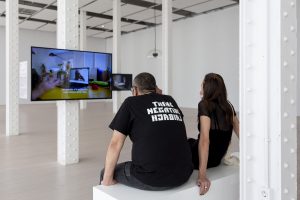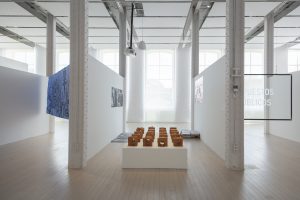I have been following Núria Güell’s work for quite some time and what has always struck me is her capacity to subvert norms throughout her artistic actions that reveal the precarious structures of the reality we live in. Her works do not operate just in the realm of art and they have an impact on her life and on the other people’s she involves. Most of the time, Güell crosses the line: for example, she puts us in front of what could happen if we would choose to act against specific moral codes, without expressing a judgement on the choice. In the occasion of her exhibition All order is required pure at Fabra i Coats: Centre d’Art Contemporani, in Barcelona, I asked her to explain some concepts that she has been developing across her career.
Alessandra Saviotti: Núria, I would like to start this interview by addressing a notion we spoke about previously, such as the “side effect” of the artwork. I am particularly referring to Toda Obrea de Arte es un Delito no Cometido, for which you invited former inmates sentenced for art-related theft crimes to work as the security staff for your exhibition. As you previously argued, working with other people could lead to a mismatch between the results and the initial intention (Medina Estupiñan and Saviotti, 2017). What were your expectations for this work and what has happened when you activated it?
Núria Güell: In Todo Orden Se Quiere Puro. Una exposición retrospectiva, I delved into the preachy drift of our society, for which I have wanted to face power, punishment, and the other side of morality. My interest was to reveal and make perceivable the violence of the State, or that of the constituted authority. “Bad behaviour” produces a judgment about one’s conduct, that is not based on anything other than conventions that continuously change. The notion of truth, justice, good and evil lead to theological concepts; they are tricks that try to cover up the lack of legitimacy of power. Power rewards and punishes according to an order that is anything but pure, although it always tries to project a particular image of purity or rationality. In addition, the law is the armed force of morality, which marginalizes the individuals considered dangerous or sick in the name of common good. However, all of this happens with the consent of the non-incarcerated population. Toda Obrea de Arte es un Delito no Cometido has been a device that broke the distance between “supposedly-non-criminal-citizens” and “criminal-citizens”. The encounter between “profiled” bodies and their opposite has revealed the contradictions of power relations that, in my opinion, have paved the way for a reflection about ethics. The work aims to put in crisis the moral beliefs and the prejudices, perceived as the only possibility that the human being – intended as the speaking animal – has to take responsibility for the relation with his peers, animals and environment. For this work’s success, negotiation with the institution has been determining, however what happens in the show is only the tip of the iceberg.
I was intrigued by the choice of presenting new artworks as part of your retrospective. I might be wrong, but I interpret it as another act of refusal of predetermined rules and of certain expectations that the art system has towards the artists. For example, what happens when you commission other artists to re-make one of your artworks? Is it about testing the reclaim of one’s own artistic power (even if it is limited to the deputed structures in this case) and at the same time finding a ‘signifier’ that is not an object?
My intention in conceiving Retrospectiva en tercera persona was, on the one hand, to question ourselves about the limits of what we call a “work of art”; on the other hand, I wanted to take action on the context in which my work unfolds. Although it still survives in some art circles, the idea of the artwork intended as an autonomous object has been explicitly questioned by many practitioners of the sector. The attempt to break with the thesis that art is a commodity or a “valuable object” has been debated at least since the 1960s. The theoretical framework in which my research is placed considers the artwork as an exercise carried outside or at the edges of the cultural realm. It is free from the logic of the capital or the value chain. When I involved other artists in the creation of a version of some of my works, I asked them to reactivate that exercise starting from their point of view. Institutions need to operate or articulate their position as if the work of art were something tangible and well defined, they need objects. However, this is only a pretext to destabilize what people takes for granted as culture. It is a kind of exercise in subversion. In other words, paraphrasing Deleuze, it is all about refuting the certainties and the public opinion’s conventions, and so the mainstream culture, so that a bit of fresh air could enter. Moreover, since I am neither an autonomous subject nor an autonomous artist, I wanted to show something that is part of me. That is the reason why I invited other artists. In the second act of the show, I intended to question both the autonomy of the work and the artist’s one. The artworks do not come out of anywhere; we soak up everything we perceive: the creative act is a mix of existing elements which might come from any domain and be material and immaterial.
One aspect of your work La Banalidad del Bien is to renounce your artist status to gain that of religious of the Catholic Church on order to obtain fiscal benefits. What if we had an army or church of artists, do you think that the power dynamics would change? What it would imply for your research?
First of all, let me clarify something to avoid any possible confusion: in that work I did not give up being an artist. The gesture of changing my working condition to that of “religious” came from my encounters with the YouTuber nun and the parish priests of my region, as a consequence of whom I decided to include the administrative bureaucracy between the “game rules” to draw attention to the artist’s precarious condition in the legislative or administrative regulation. Said that, it is really difficult for me to conceive the idea of an army or a church of artists if it is not just a comic gag. The power of artistic practice in based on the intervention on the sidelines of institutional dynamics. Making a comparison with Lacan’s psychoanalytic theory, which I like to delve into, the artistic practice would be a kind of “not-all” between all the professional practices, therefore, the artist must remain faithful to that “not-all”, preventing their practice from being co-opted by the power dynamics of culture. In other words, the artist cannot be part of an army or a church, which are the direct emanation of the “all”, and devices of power. Power, however, it is represented, belongs to culture, and vice versa. Modern artistic practice, which I do, is essentially anticultural, as Foucault already pointed out between 1983 and 1984. Why? Because modern art questions about the status quo, the given forms, conventions, traditions, consensus, what it is taken for granted, and everything that constitutes a culture. The relationship that art has with culture is conflictive. Culture is essentially conservative, and it inhibits everything that questions it, if it cannot repress the dissent, it captures it and converts it thus it nullifies the power of art. What happens when an artistic practice becomes cultural? Well, it becomes part of the power propaganda, whatever form it takes. If art were not anticultural, the culture would suffocate us. That is why the artist must try to stay in “no one’s land”, even though his sustenance could come from cultural institutions. A “critical culture” can only be a “critique of culture” and so a critique of the community, since all communities are cultural. In short: the task of art is to dissolve without instituting. Hence the subversion to which I alluded earlier. Whether something like this is achieved or not is another matter, but that is the only meaning that I find in what I do.
Alessandra Saviotti
Info:
Núria Güell
www.nuriaguell.com
 Núria Güell. La Banalidad del Bien (2021). Installation view at Fabra i Coats – Centre d’Art Contemporani, Barcelona. Photo: Eva Carasol, courtesy the artist
Núria Güell. La Banalidad del Bien (2021). Installation view at Fabra i Coats – Centre d’Art Contemporani, Barcelona. Photo: Eva Carasol, courtesy the artist
 Núria Güell. Retrospectiva en tercera persona (2021). Installation view at Fabra i Coats – Centre d’Art Contemporani, Barcelona. Photo: Eva Carasol, courtesy the artist
Núria Güell. Retrospectiva en tercera persona (2021). Installation view at Fabra i Coats – Centre d’Art Contemporani, Barcelona. Photo: Eva Carasol, courtesy the artist
 Núria Güell. La Banalidad del Bien (2021). Enlarged reproduction of the documents that certify Güell’s registration in the Special Regime of Social Security contributions, as a religious of the Catholic Church. Fabra i Coats – Centre d’Art Contemporani, Barcelona. Photo: Eva Carasol, courtesy the artist
Núria Güell. La Banalidad del Bien (2021). Enlarged reproduction of the documents that certify Güell’s registration in the Special Regime of Social Security contributions, as a religious of the Catholic Church. Fabra i Coats – Centre d’Art Contemporani, Barcelona. Photo: Eva Carasol, courtesy the artist
 Núria Güell. Todo obra de arte es un delito no cometido (2021). Amadeu Casellas (on the left of the image), one of the ex-prisoners hired to work as room guards and informants. Fabra i Coats – Centre d’Art Contemporani, Barcelona. Photo: Eva Carasol, courtesy the artist
Núria Güell. Todo obra de arte es un delito no cometido (2021). Amadeu Casellas (on the left of the image), one of the ex-prisoners hired to work as room guards and informants. Fabra i Coats – Centre d’Art Contemporani, Barcelona. Photo: Eva Carasol, courtesy the artist

is a contemporary art magazine since 1980






NO COMMENT